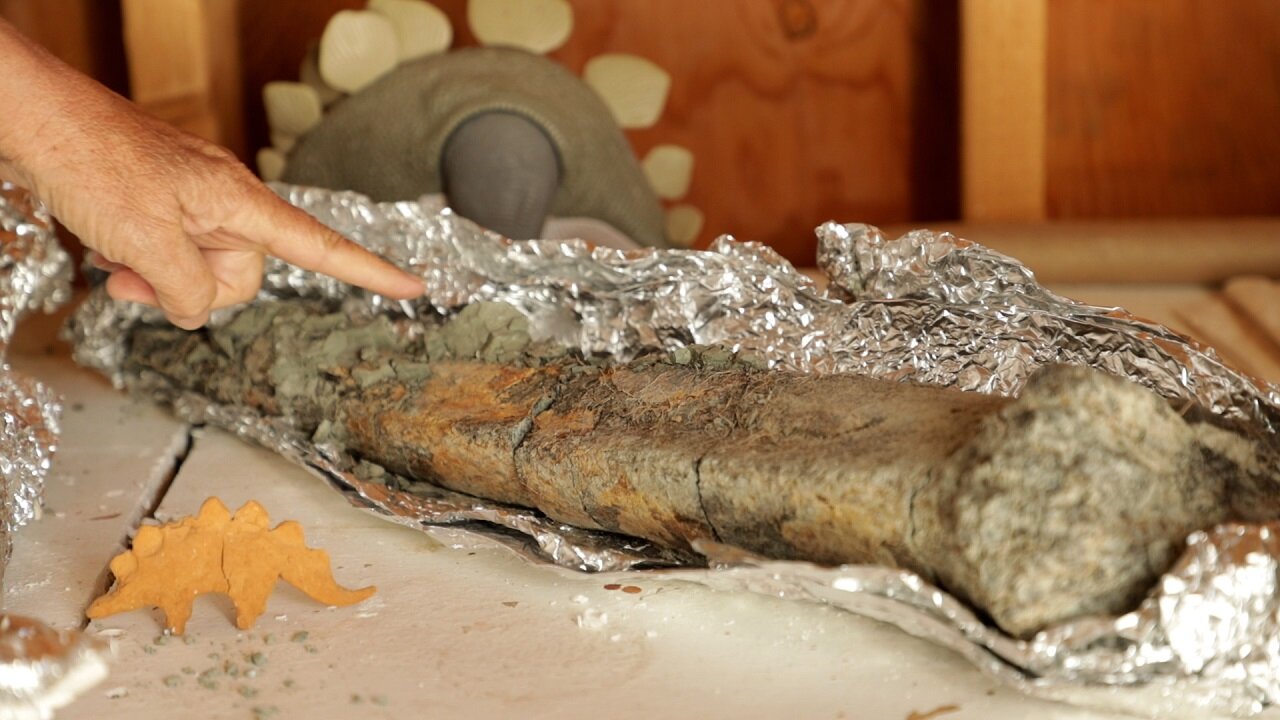Bones that bond: Women-led paleontology team unearths the power of Earth’s history

ROCK RIVER, Wyo. — Down a winding dirt path and into a vast valley surrounded by bluffs and a river blossoming with lush vegetation, a fossil quarry tells the tale of Earth’s past.
The crew of a female-led dinosaur dig traveled to Wyoming to uncover a time capsule of prehistoric life that dates back to the Jurassic era around 150 million years ago.
“The Earth communicates it’s history with us,” paleontologist Jana Mckeeman reflected. “And if we pay attention, take time to look and listen, we can start to put the pieces of Earth’s history together.”
Mckeeman leads this crew as part of the Denver-based organization Western Interior Paleontological Society. She has been with the group for more than 25 years and has worked with field crews and as a fossil preparator. She has a Certification in Paleontology from the Denver Museum of Nature and Science.
“We bring a special collaboration of teamwork,” Mckeeman said. “And when you’re out here in the field there’s no ego. You just can’t have an ego about working in paleontology. And it takes a team to accomplish getting fossils from the ground to the museum. You just, not one person can do it alone.”

The quarry, located near Laramie, Wyoming, has a rich history of fossils. And along with that history came a slew of fossil hunters dating back to the late 1800’s. Comprised of scientists from competing universities, specimens were eagerly extracted and hoisted onto a nearby train to be taken back East for further examination.
[Related: The Two Paleontologists Who Had a Bone to Pick with Each Other & The Bone Wars: From Wyoming Tales and Trails]
But on this excursion, fossils collected from the quarry will be carefully extracted and delivered to the Tate Geological Museum in Casper, Wyoming where staff and volunteers will have the opportunity to work with the bones. Through a meticulous process of removing the surrounding rock from the fossils, paleontologists will be able to gain a broader understanding of the anatomy and significance of the dinosaurs found in this site.
The means by which a fossil is removed from the quarry helps ensure the protection and safe transport of the specimen.
In order to do this, the fossil is jacketed in foil and plaster bandages. A layer of foil is placed on the fossils as a barrier layer to the plaster. Next, burlap sacks are cut into strips. Then plaster powder is mixed with water to make a thick liquid. The burlap strips are dipped in the plaster and quickly applied to the fossil. Once the fast-setting plaster hardens, workers undercut the jacket to form a pedestal underneath the fossil. The fossil is then loosened from the pedestal and quickly flipped over. More foil and plaster are then applied to cap the fossil. Once hardened, the fossil is ready to be picked up by the museum staff.
“It’s like a slow-moving Easter egg hunt,” quarry liaison Anita Colin said. “And you never know what you’re going to find next because there’s thousands of bones in this quarry and all different kinds of dinosaurs. And it’s exciting to see what you might find next.”
Among the many dinosaurs found at this location are Allosaurus – a meat eater resembling the late cretaceous T-Rex, and the plant eaters Camarasaurus and Stegosaurus.
Colin emphasized the sheer size of these ancient creatures. Inside a small cabin, she reached for a Stegosaurus tail spike that was recently discovered. The charcoal-colored spike is over a foot long and as thick as a baseball bat. She beamed with joy as she touched it.

“This was the age of Stegosaurus,” Colin said.
She picked up her plastic model of a Stegosaurus to showcase how tiny the tail spike is in relation to the rest of the dinosaur.
“If you think about this structure being on this animal, you get an idea of how enormous the Stegosaurus is,” Colin said.
Curiosity and wonder are the hallmarks of life in the field.
“It’s kind of a wonderful life being in the outdoors,” volunteer paleontologist Brenda Johnson said. “It’s so beautiful. And it’s soothing. You know you can dig and think and dig and talk to your quarry mates. And you have a bond that is both scientific and personal that I find really fulfilling. It’s just camping, and treasure hunting all wrapped up into one.”
Like Mckeeman, Johnson is a 25-year member of the Western Interior Paleontological Society. Over the years Johnson has gone on numerous field digs across the West, and has acquired her Certification in Paleontology from DMNS.
The gravity of the work this team is doing generates a constant source of electricity and excitement throughout the quarry workers.
“It’s powerful to be that person who uncovers a bone, and you realize when you uncover that fossil you are the very first person ever to lay eyes on that fossil that has just been unearthed,” Mckeeman said.

This is last of several trips that have taken place this season. The quarry has been excavated by different groups for around 30 years, and excavation will continue so long as the site continues to yield fossils.
Their passion for the pursuit of scientific discovery is palpable, as in their advocacy for women to continue to pursue the field of paleontology.
“What I would say to a young girl who really wants to get into this: don’t give up,” Mckeeman said. “There are more women becoming involved with science, and mentorship is becoming more available. We need to keep encouraging young girls and women to get into fields of science, but we also need to be those examples for them that yes they can do this. They really can.”
Kate Johnson is a video editor with Rocky Mountain PBS. You can email her at katejohnson@rmpbs.org.
Alexis Kikoen is a senior producer at Rocky Mountain PBS. You can reach her at alexiskikoen@rmpbs.org.
